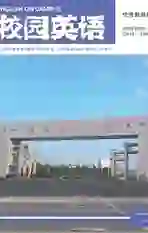Sixcommonmethodsforadvertisementtranslation
2014-02-10刘宝亮
刘宝亮
【Abstract】With the process of globalization and economic development in the whole world, advertisements have moved into every peoples life.There is a growing need for advertisement communication.
【Key Words】Methods;Advertisement Translation
The rapid development of international business exchanges and trades needs the help of advertisement translation to bring more benefits in the fiercely-competitive society.Thus,one should lay great emphasis on the advertisement translation.There are six common methods for advertisement translation described as follows:
1.Documentary Translation
According to Longman Dictionary of Contemporary English, documentary translation is a translation that translates each word exactly instead of giving general meaning in a more natural way.The literal translation is an approach of translation where the sentence is regarded as the basic unit of translation, while the translator is considering the textual and contextual constraints and retaining the original sentence structure and rhetoric device to reproduce the form, content and style, thats to say, the original grammatical structure is converted to the closest corresponding structure in the target language to attain the effect of correspondence.
2.Instrumental Translation
Instrumental translation, also called Flexible, Dynamic, or Functional Equivalence translation, is a concept relative to literal translation (卢红梅, 2006:200).It reproduces the intention of the original advertisement.If translation is not faithful to the original advertisement or can not be accepted by the target readers, the translator has to abandon or alter the original form or rhetoric device to use expressions which are easily understood and acceptable for target readers.To achieve the final goal, the translators are allowed to take some different ways to meet the requirements.And if it is used appropriately, it can be very useful and helpful.
3.Creative Translation
In order to get more foreign consumers and attain the purpose of advertisement translation, translator is supposed to find some linguistic and cultural approaches to stimulate consumers to generate desire for purchase.So translation is no longer a way of simple conversion.Creative translation refers to a certain creative translation, but not pure creation.Creative translation requires the translator to have the rich knowledge, bold imagination and expansive thinking.The translator is not confined to the literal meaning, while he is good at digging the deep meaning and puts boldly its individual creation into translation.
4.Supplementary Translation
This category refers to that the translator makes an appropriate increase for certain purposes in the content in the translation process.It includes two kinds of situations; the first is to extend and expand some key words meaning in the original text, making its implied meaning emerge, so in most cases, the meaning of the translation text goes beyond original meaning.The other one is customary, for example, four character idioms in Chinese.They are concise and comprehensive; their connotations are rich, so in terms of advertising, neat antithesis is often seen in the Chinese translation.
5.Condensed Translation
As the name implies, condensed translation is contrary to supplementary translation.It is a means of translation in which to achieve a certain purpose, translators delete, compress and even omit come unimportant parts in the process of translation.Because of the difference in the culture and language, translators should make full consideration to the language that will be used in the advertisement translation to achieve the purpose of the original advertisement.
6.Parody
As Vermeer once said: “Every translation is directed at an intended audience, since to translate means to produce a text in a target setting for a target purpose and target addressees in target circumstances” (Nord, 2001:12) it means that source text only plays the role of providing information and translator can make some changes to accomplish the functions of the original advertisement.It provides some opportunities for the use of parody.
Parody is to apply the prevalent English or Chinese idioms, common saying and allusions to the translation of advertisement.They are easy to learn and leave deep impression on the person.
References:
[1]Nida, Eugene A.Language, Culture and Translating[M].Shanghai: Shanghai Foreign Language Education Press,1999.
[2]Nord, C.Translating as a Purposeful Activity: Functionalist Approaches Explained[M].Shanghai: Shanghai Foreign Language Education Press, 2001.
[3]陈小慰.翻译功能理论的启示—对某些翻译方法的新思考 [J].中国翻译,2000, (4).
[4]方梦之.翻译新论与实践 [M].青岛: 青岛出版社,1999.
[5]卢红梅.大学英汉汉英翻译教程[M].北京: 科学出版社,2006.
[6]余星.现代广告英语翻译[J].宁德师专学报,2005, (l).
